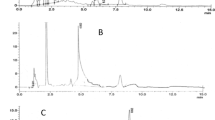Abstract
Dissipation pattern and risk assessment of tebuconazole in grapes was studied following two application rates (250 and 500 mL ha−1) under tropical humid climatic condition of West Bengal during 2009–2010. Residues of tebuconazole were confirmed by liquid chromatography–mass spectrometry. The average recoveries were found 87.53 % and 89.67 % for grapes and cropped soil respectively. Following the first order kinetics the fungicide dissipates in grapes with a half-life (T1/2) value ranges between 2.62 and 2.86 days irrespective of seasons and doses. No residues of tebuconazole were detected in harvest grapes and soil samples which refers that, tebuconazole does not possess any background contamination property in grapes. So it may be concluded from the study that tebuconazole does not possess any toxicological property when applied at the recommended dose.



Similar content being viewed by others
References
Anonymous (2004) The prevention of food adulteration act: Ministry of Health & Family Welfare, Gazette of India, extraordinary, part II, section 3
Chuan LIU (2009) Determination of tebuconazole residue in soil and apple. J Anhui Agric Sci 37:135–139
European Commission Health and Consumers Directorate General: review report for the active substance tebuconazole, SANCO 171/08- revision 1. 9 Sept 2008
European Food Safety Authority Journal (2009) 7(10):1368
FAOSTAT (2007) FAO Statistical Database. http://www.fao.org
Food and Drug Administration of the United States (2003) Pesticide tolerances. http://www.cfsan.fda.gov
Hoskins WM (1966) Mathematical treatment of the rate of loss of pesticide residues. FAO Plant Prot Bull 9:163–168
http:www.fao.org/ag/AGP/AGPP/Pesticide/JMRR/Download/2004eva/TEBUCONAZOLE.pdf. Accessed 19 Dec 2008
Jyot G, Arora P, Saha S, Singh B, Singh R (2009) Persistence of trifloxystrobin and tebuconazole in grape leaves, grape, berries and soil. J Environ Contam Toxicol 84(3):305–310
Mohapatra S, Ahuja A, Jagadish GK, Prakash GS, Kumar S (2010) Behaviour of trifloxystrobin and tebuconazole on grapes under semi-arid tropical climatic condition. Pest Manag Sci 66(8):910–915
Pezzuto JM (2008) Grapes and human health: a perspective. J Agric Food Chem 56:6777–6784
Sandra M, Menary RC, Davies NW (1999) Dissipation of propiconazole and tebuconazole in peppermint crops. J Agric Food Chem 47(1):294–298
Stajnbaher D, Zupancic Kralj L (2003) Multiresidue method for determination of 90 pesticides in fresh fruits and vegetables using SPE and liquid chromatography–mass spectrometry. J Chromatogr A 1015:185–198
Tomlin CDS (1997) The pesticide manual. British crop product council, Surrey
Author information
Authors and Affiliations
Corresponding author
Rights and permissions
About this article
Cite this article
Kundu, C., Goon, A. & Bhattacharyya, A. Persistence Behaviour of Fungicide Tebuconazole in a Viticulture Application. Bull Environ Contam Toxicol 92, 415–419 (2014). https://doi.org/10.1007/s00128-014-1223-8
Received:
Accepted:
Published:
Issue Date:
DOI: https://doi.org/10.1007/s00128-014-1223-8




